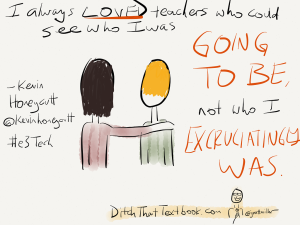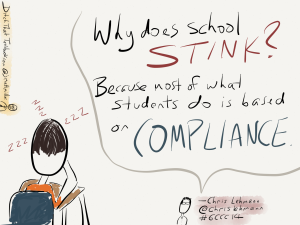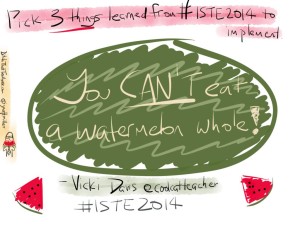

I learned a lot about teaching with technology, about teaching well and about great things happening in education this summer. Here are my best 10 lessons learned. (Sketch by Matt Miller)
Some people spend most of their summer vacations at the beach, in the back yard or at the movies.
Not me. (Although I did spend some time at each of those!)
Much of mine was spent at educational technology conferences. Indiana had 19 of them all over the state, and I was fortunate to attend 12 of them.
The best parts?
As I try to distill a great Summer of eLearning into one blog post, here are 10 lessons I learned:
George Couros is one of my favorite education keynote speakers. His presentations always evoke so many emotions, and a video he showed has resonated with me ever since.
In this video below, a girl stands atop a snowy hill trying to talk herself into doing a ski jump. You can hear her voice quivering, but she eventually makes the jump. Her jubilation is evident even before she makes it to the bottom of the slope.
As teachers, we want to make great leaps in what we do but sometimes lack the courage to push ourselves on to that slope. But when we get to the end of our new endeavor, we wonder why it took so long to try.
At every school I visited this summer, I kept noticing student technology teams.
They helped to troubleshoot problems for presenters and participants at conferences. They presented new ideas to teachers. They introduced speakers and even gave speeches in front of large crowds.
Kids have great skills — in technology and in so many other facets of life. We so often leave teaching to the teachers when kids are dying to show what they know.
If students are an untapped resource at your school, consider finding ways to utilize them.
These days, if we want to swap ideas and opinions with top educators, all we have to do is ask.
At a conference in Jeffersonville, Ind., I walked into the auditorium and found this pack of top educators sitting in the same corner. Here were several people I greatly respected in one place.
(And what do you do when you meet people like that? Grab a quick selfie!)
Ellen’s got NOTHING on #gc3selfie @tomwhitby @thomascmurray @KleinErin @plugusin @8Amber8 @kylepace @Bookbandwidth pic.twitter.com/YdOy46xADj
— Matt Miller (@jmattmiller) July 21, 2014
I interacted with almost all of them that day, and they were all so approachable. They’re the same way on social media, too, and they’re full of great ideas. Ideas that will make any educator better.
If teachers aren’t tapping into the vast resources on social networks these days, they’re missing a golden opportunity to learn, connect and improve.
 4. See kids for who they’re going to be
4. See kids for who they’re going to beKevin Honeycutt summed his childhood up with how his family shopped for clothes.
At Goodwill. Well, in the Goodwill donation box. At night. With him diving in the box illegally to grab clothes for him and his siblings.
He moved from school to school as a child. The teachers he remembers most, he says, are the ones who saw the potential in him … the ones who saw who he was going to be instead of who he was at the moment.
See kids for who they’re going to be.
There were so many sessions on the flipped classroom at so many conferences — around Indiana and around the world.
This tells me two things:
Teachers are getting great results from it and want to share their experiences.
Teachers are starving to learn more about it.
Dan Spencer, a teacher from Michigan and flipped learning practitioner extraordinaire, shared great resources about flipping the classroom at bit.ly/flipgccc14. If you hunger for more about the flipped classroom, this is a good place for new ideas.
 6. No silver bullet … silver BBs
6. No silver bullet … silver BBsSo many people — politicians, education consultants, people with no experience in education — feel like they have the silver bullet, the perfect singular cure — to solve the woes of education.
Over the years, I’ve become very wary about those kinds of people.
I tend to agree more with the aforementioned Dan Spencer, who cautioned us to look past the silver bullets to cure all of the ills.
We need more silver BBs — the little cures for the little problems that lead up to big results.
 7. Why do schools stink? Compliance
7. Why do schools stink? ComplianceFor decades and longer, schools have pushed kids to follow the rules.
Get to class on time. Sit in your seat. Don’t talk. Do your work. Stay in your seat until the bell.
These days, the world is owned by the ones who aren’t afraid to shake things up.
It’s owned by the ones who question the rules and do things differently.
Schools stink, according to Chris Lehmann, because of compliance.
This guy should know — when he got a vision of how school should be done, he started his own school — the Science Leadership Academy.
Instead of complying, he said, let’s get kids creating and questioning and thinking.
In some ways, I feel like I attended the ISTE conference — the premier education technology conference in the world — but I did it from my desk in my living room.
People at the conference were sharing takeaway ideas, quotes, links and other resources freely on social media. And I was eating it up.
This further highlights the power of being a connected educator — make those connections to others and constantly learn from them.
As Kevin Honeycutt said in the speech I mentioned above, you’ve got to “L2L2L” (learn to love to learn).
After doing a session at a conference on video chats in the classroom and making global connections, I was contacted by a teacher in Canada who was dying to do an activity on Skype. She wanted to do a Mystery Skype activity that day, and I had just wrapped one up with a group of teachers.
So I said yes … even though I didn’t have anyone else to participate yet.
I sought out student helpers at this conference in Yorktown, Ind. I knew they would be looking for something fun to do.
They were.
These students gathered around a cafeteria table to video chat with these Canadian students.
They had a great time. And they were using problem solving and geography skills.
“Teach Like a Pirate” author Dave Burgess asks this: if your students didn’t have to be there, would you be teaching to an empty room?
In this case, those students would be there — because it was fun.
 10. You can’t eat a watermelon whole
10. You can’t eat a watermelon wholeI saw so many educators this summer who gathered a wealth of new ideas and information at conferences.
Then they felt overwhelmed with a sense of “Where do I start?”
The best advice I’ve heard from that comes from Vicki Davis, author of the Cool Cat Teacher blog.
She suggests grabbing on to one or two main ideas you want to implement and owning them. Don’t try to implement everything.
Why? You can’t eat a watermelon whole, she says, and you can’t implement all of those ideas all at once.
What’s your biggest takeaway from this summer? Do you have a reaction to one of mine? Share it in a comment below!
(For notifications of new Ditch That Textbook content and helpful links, “like” Ditch That Textbook on Facebook and follow @jmattmiller on Twitter!)
Interested in having Matt present at your event or school? Contact him by e-mail!

Session expired
Please log in again. The login page will open in a new tab. After logging in you can close it and return to this page.